#handmaids tale imagery
Text
5x10 - Safe (Imagery)
I read (on Tumblr or elsewhere) that:
- In the first photo, Nick's background looked like the United States flag.
- In the second photo, it looks like he is bearing his cross.
Do not hesitate to contact me and I will credit you.
(Edit) Scarlet had noticed the cross on Nick's back.
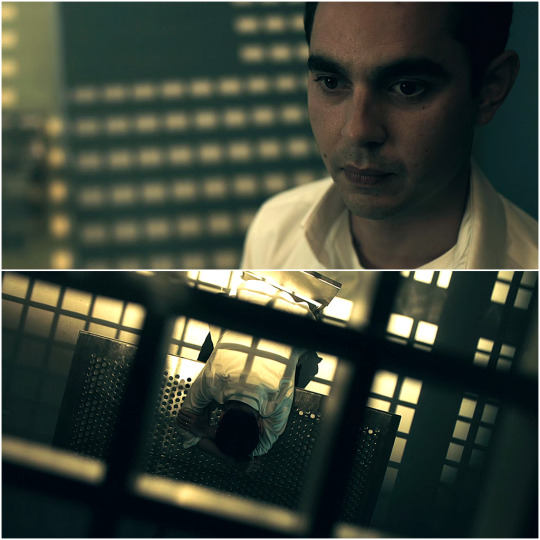
Meaning of the flag's colors:
- Red for valor, white for purity and blue for loyalty.
Meaning of bear your cross:
- A burden or trial one must put up with.
Source Pictures: Screenshots (by me)
19 notes
·
View notes
Text
one white feminism woke usa take away from the death of my last braincell
0 notes
Text
Okay but like, what's with fandoms and their recent obsession with "purifying" themselves and the content in them?
It's one thing if a content creator is outed as a pedophile or a racist or a xenophobe.
What I'm talking about is this newfound hatred towards dark fics and dark subject matter in general. It's like people don't understand that it's fiction. Fiction is not reality. Even if the writing is disgusting or amoral, it's not real. And you don't have to read it.
People have been writing weird shit for ages. So how come we only ever see these purity enforcers attacking fic writers or fan artists in fandoms?
Like, in the COD fandom I've seen a bunch of people getting hounded for posting or consuming dark content, I've also gotten a couple messages about it. And, like, hey buddy? Who really cares.
Fiction and reality are two separate things.
Also, why are you attacking me, a 20 year old who lives with their mom and writes for their ten consultant followers and not, oh, I don't know...
Stephen King, who has that whole underage sewer orgy scene in It.
Or the e creators of call of duty for creating literal propaganda. Because, hey besties, yes, that's what COD is. Propaganda. They want you to see it and be like, "yay, guns and the military!" And that's the thing about fiction. It's allowed.
The issue at hand is, in my mind, an issue of deeper reading comprehension or complex thoughts. And a lack of understanding of catharsis.
No one is saying these things are good. But these things exist in the world, like it or not. And in my mind, it's better to portray them in fiction than not at all. Because at least in portraying it awareness can be spread.
And again, if you don't like something, if it triggers you, just don't read it. It's simple. Like if you're watching a movie and can't stand blood so you cover your eyes not to see. You aren't going to go after the director are you? No. You're going to take steps to protect yourself against content you don't want to see or consume.
I think it's an issue of separating fan works from "real" works. Those who say fan art isn't real art or fanfiction isn't real writing. So perhaps in those people's minds, fan works, not being "real" means that they shouldn't portray things we see in reality.
All this to say here's a non-definitive list of novels with dark/disturbing content that these people would want to oppose:
It by Stephen King: The kids having an orgy in the sewers, child abuse, sexual abuse
Lolita by Vladimir Nabokov: pseudo-incest, hebephilia
The Handmaid's Tale by Margaret Attwood: Women being stripped of rights, education, loss of bodily autonomy, forced breeders (at the hands of a government)
The Wasp Factory by Iain Banks
The Road by Cormac McCarthy: People keeping other people for food, people keeping women as breeding stock (at the hands of bandits in a post-apocalyptic world)
Flowers in the Attic by V. C. Andrews: child neglect, child abuse, forced isolation, incest, rape
1984 by George Orwell: totalitarianism, government surveillance, insignificance and weakness of the individual
The Stand by Stephen King: sex, rape, ableism, abuse of handicapped people, violence and killing
Maus by Art Spiegelman: depiction of violence, concentration camps, Nazis, Nazi imagery, dehumanization, starvation, mass murder
Frankenstein by Marry Shelley: human experimentation, grave robbing, necromancy, technical necrophilia, murder, revenge, suicide
In the Miso Soup by Ryū Murakami: pedo/hebephilic relations, sex industry, murder
Blood Meridian by Cormac McCarthy: graphic depictions of violence, use of slurs, child abuse, infanticide (? Been a while since I read it so I might be misremembering), pedophilia, rape, sexual assault and violence
Tender is the Flesh by Agustina Bazterrica: cannibalism, forced breeding, objectification, slave trade, people being bred and sold for meat
A Clockwork Orange by Anthony Burgess: sadism, sexual violence
The Girl Next Door by Jack Ketchum: captivity, torture, torture at the hands of children, violence, sexual violence, based on a true story
Lord of The Flies by William Golding: shows the truth of human nature, dissolution of society and it's rules, violence as a basal instinct
The 120 Days of Sodom by Marquis de Sade: sex, sexual violence, rape, sex trade, pedophilia, incest, abuse, literally just the whole book
Trainspotting by Irvine Welsh: mental illness, drug use/addiction, infant death
American Psycho by Brett Easton Ellis: violence, gore, rape, murder, torture, misogyny, sadism
A lot of these books, though considered scary and disturbing and gross, are also seen as classics.
It's not the fault of the author or the media they create, but that of the consumer.
You can find it icky and gross after reading or watching such things. Most of the time you're supposed to. That's a good thing, it means you're human. These things make you think and feel and emphasize.
To control what can and cannot be written is censorship. To control how certain things are portrayed is censorship.
Be aware of the media that's out there, because these disturbing things are real issues out there. And if you can't stomach it, don't consume it.
Simple.
24 notes
·
View notes
Text
Authors On THG Writing Hiatus Masterlist (9)
Part 1 / Part 2 / Part 3 / Part 4 / Part 5 / Part 6 / Part 7 / Part 8 /
***Active (on this blog) is defined as a blog/writer who has updated within the past year. Inactive (on this blog) is defined as a blog/writer that has not been updated at all in the past year+. On THG Writing Hiatus (on this blog) is a blog/writer who has updated within the past year but has not posted a fanfic in the fandom in the past year BUT they may return to writing in the future. Lists will be updated as needed based on activity. ***
Created: November 17th, 2023
Last Checked:----
notalone91-ao3, ff.net, tumblr
Popular Fic: Reading the Signs
Katniss' marriage is in shambles. She's out of a psychiatric facility and back in Seam City to try and fix what's left, but a new friendship might bring her more than she bargained for. T for extremely harsh language, allusions to sexual relations, mental health issues, and about a million other things. (Silver Linings Playbook AU.).
oh_wellau-ao3, ff.net, tumblr
Popular Fic: Wool
Set in those first tentative steps towards each other, in between the healing and the growing back together. I want to tell him that I appreciate that he’s still here, that he’s hasn’t abandoned me, even though sometimes I don’t make for the best company. I want to tell him that he is more than just a friend, that he leaves me at a loss for words and my stomach doing flipbacks. And that I like how it feels. That if I could freeze a moment and live in it forever, it would be us cuddling under a soft orange blanket, basking in front of the fireplace in our home, the sun setting outside.
ohmakemeahercules-ao3, tumblr
Popular Fic: Steadfast Waltz
Katniss and Peeta are on the Victory Tour. Effie Trinket informs them President Snow has requested the couple dance a waltz at his annual ball. Katniss begrudingly agrees. She and Peeta were still on shaky ground since the last Games. Will they be ready by showtime?
PM Addict/addictedtopeetamellark-ao3, ff.net, tumblr
Popular Fic: The Call
Peeta makes one bad decision one night…loosely based on the Backstreet Boys song "The Call".
purplehedgehogskies-ao3
Popular Fic: Where Her Heart Should Be
College student Katniss Everdeen has no idea where she's headed in life. On campus, everything is strange and new, and though home is only a few miles away she feels detached from everything she's ever known. Except for Peeta, the charming boy from the bakery back in her hometown. Everlark AU, with a bit of Finnick and Annie too.
ra3lynn3-tumblr
Recent Fic: Sober Heart
Tumblr only! Multiple works present!
Ro Nordmann-ao3, ff.net, tumblr
Popular Fic: STATUS QUO
STATUS QUO: to keep things the way they presently are… Follow the Law we are bound or face the consequences. Inspired by The Handmaid's Tale by Margaret Atwood [Previously posted; revised new version for tlcullen132]
RoziCanuti/the_truth_is_in_the_tooth-ao3, ff.net, tumblr
Popular Fic: Seven Days in Sunny June
Katniss went to relax and clear her head at the beach with her friends, meeting Peeta wasn't part of her plan. Having feelings for him wasn't either.
RunOn-ao3, tumblr
Popular Fic: I Love You To Mars and Back
Believing he has perished in a sandstorm, Peeta's crewmates abandon him on the surface of Mars where he must now figure out how to make 31 days worth of supplies last for 4 years. Meanwhile, recent college graduate and grunt in SatCon, Katniss notices anomalies in the satellite imagery that reveal that Peeta is alive. Her discovery unites NASA, the nation, and the world in a race to rescue the stranded astronaut before time runs out. Haymitch, Director of Mars Operations, assigns Katniss to watch over Peeta on Mars. What begins as an almost embarrassing demotion evolves into her genuinely caring for him and eventually falling in love. There's only one problem. Peeta doesn't even know she exists. What will happen when he returns home?
SabaceanBabe-ao3, ff.net, tumblr
Popular Fic: Treading Water
They don't tell you when you go into the arena that the lucky ones are those who die.
#writing-hiatus#masterlist#everlark fanfiction#thg fanfiction#everlark#thg#writing-hiatus authors#writing-hiatus authors masterlist
8 notes
·
View notes
Text
Just found out tatsuya ishida believes that random babies are stolen from their mothers after birth when people (he probably thinks only gay people) adopt. surrogates. He doesn't know what a surrogate is. That woman very willing get pregnant for the sole reason of giving another couple a child. He's a very grown ass man and he thinks nurses are with the government or some shit and that they can just take babies and the mothers have no say in this. He's made SEVERAL comics about this. Like. What was the statement? Anti adoption? Does he think this will happen in the future? I thought maybe it was some fantasy scenario (he used handmaid's tale as imagery), but like did he fucking read handmaid's tale lol? Cannot believe people defend him, he also denied the Ukraine war as it was happening. Absolutely batshit man
7 notes
·
View notes
Text
Plastic Theatre In Prose: Aşk-ı Memnu
For a while I’ve really enjoyed reading what I can only describe as ‘Plastic Theatre’, not simply in plays, but in prose.
Plastic Theatre is known as a technique used by 20th century dramatist Tennessee Williams, known for A Streetcar Named Desire, The Glass Menagerie and Cat on a Hot Tin Roof among other plays (these three that I have read/seen are excellent). It involves a symbolism that borders on the surreal and a heavy awareness of the spaces that characters operate in as representative of their inner states or relationships. If the curtains are blue, there’s a very good reason.
I haven’t, however, been able to find any criticism that makes the jump from Williams’ on-stage Plastic Theatre to its mirrors in prose. (If anyone knows of any, please direct me to it)
Margaret Atwood is the author who I saw it in first. She is an incredibly deliberate author, playing with language constantly, and so, of course, when she describes a space, she does not do so without good reason. The constant and intoxicating symbolism of The Handmaid’s Tale may be forgotten sometimes in favour of its high-concept, but one must note that the actual plot of the novel is very limited (just as our narrator is very limited). It is the prose, the linguistic entanglements and the imagery of flowers, of eggs, of corpses, that sustains engagement and creates such a powerful and meaningful story.
Angela Carter’s The Bloody Chamber (which I have some issues with, plot-wise) is linguistically and symbolically incredibly rich. Where I was tired by the constant returns to that (I don’t want to talk about it; if you know, you know) as apparently the only means of darkening a fairy tale, my interest was maintained by the cleverness of the prose and the richness of the text. As with Atwood, every detail has a secondary meaning or a hundred secondary meanings.
Halit Ziya Uşaklıgil’s Aşk-ı Memnu seems also to have an element of plastic theatre in its construction, gesturing not only to symbols of space, dress and action but also to genre. Plastic theatre in Aşk-ı Memnu is not so sustained as in the works of modern writers, but equally it is more sustained and intrusive onto naturalism than its contemporaries.
Firstly, Halit Ziya is luxuriously heavy-handed in the names he gives his characters; even in the text, he cannot help but inform us that ‘through a strange irony she was taller and more slender than her name’, a playful hint not at all distant from Williams’ Blanche dissecting her own name so falsely in A Streetcar Named Desire. Beşir, bringer of good news or prophet, seems almost to give the game away before he has begun.
Yet Halit Ziya does give the game away before he has begun. Forbidden Love and the immediate rendition of Firdevs’ history sets up Bihter’s fall from the very beginning and, like all adulterous women in such novels, her death feels inevitable (I am feeling very tempted to write another post about the agency dynamics of why these women must, narratively, at least, end in disaster). There are few narrative surprises in Aşk-ı Memnu. What is there in abundance, however, is linguistic and symbolic art.
I will only consider the first chapter in detail, but to do so will require much ranging across the text regardless.
From the first chapter, Halit Ziya puts perhaps excessive emphasis on the colours around the Melih Bey set, ‘Melih’ alluding to charm and beauty, the white of Bihter’s veil and the white of their boat against the mahogany of Adnan Bey’s— the innocence of Bihter and the stately rigidity of grief that her marriage to Adnan Bey will bring— and Firdevs’ wish to erase the whiteness of her own hair to prevent the returned innocence and what she perceives as the neutered sexuality of old age.
When ‘[Firdevs’] husband’s name was erased’, this is reflected in the narrative by the literal absence of him or his name. He is subsumed into Firdevs’ in the same way Nihal’s mother is into Adnan and part of Adnan and Bihter’s conflict is perhaps that neither can swallow the other into their world entirely until Bihter is dead.
The scenes between Firdevs and her husband are incredibly rich. The letter in the bouquet not only foreshadows Firdevs’ letter to Behlül, but also renders an image of Firdevs’ nature: a beautiful exterior which conceals an interior of unknown substance. Halit Ziya is a writer; he treats word and narrative as powerful (see the semantic field of literature, narrative and the physical object of the book when Behlül discusses his romantic feelings). No matter how grotesque Firdevs’ external pursuit of beauty becomes, she is notable for having the power of word and falling into the trap of its becoming revelation. She keeps her love letters in the yonic drawers and her husband savagely destroys in what can be read as an attempt to wrest back the masculinity that was lost in the erasure of his name, but when he is dead, Firdevs reasserts herself as masculine in power. She will hunt for a yonic ‘purse’, predatory, though unsuccessful.
The dynamic between public spaces and private spaces is also masterfully utilised. It is in the semi-public space of the river and the boats that Adnan Bey and Bihter’s relationship is born, but it is also there that Firdevs is first revealed to her husband. Forests also function in a similar way— a space where social convention is briefly confused, as in Chapter Seven’s picnic and Chapter Nineteen’s magical forest, oozing with the mutability of a Shakespearian or folkloric forest.
Outside, the narrative concerns itself with fashion, with known histories, with reputation and with mere flirtation, but when Nihat Bey brings the women inside, into their private sphere, the narrative immediately switches to domesticity and marriage. Where the externally focused Firdevs had managed to dominate the novel’s opening, now the internal world belongs to Bihter.
The more the narrator retreats, with Bihter, from the outside world, to the interior of the house, to her own small room, the more aware of her interior thoughts we become and the more tightly she seems to be bound by circumstance.
The early imagined ‘rainbow [...] deluges of green, blue, yellow and crimson, [...] sunshine composed of emeralds, rubies, diamonds and turquoises were being poured’ seems to signify a point of multiple paths, but also becomes the world of her relationship with Adnan. Like Stanley and Stella’s coloured lights in Streetcar, colour becomes dualistic in Chapter Eight, the luxury of jewels and silks becoming the oppressive greens, blues, yellows, and reds flowed over the shadows, creating and destroying each other. These colours of experience, pulling her from her initial ties with white, will once then again morph in to become an emblem not of Bihter and Adnan Bey’s relationship, but of her independence. Reconfigured, Chapter One’s rainbow is now representative of Bihter’s escape from Firdevs, just as Chapter Eight’s is her escape from Adnan into the arms of whatever love she can grasp, be it from herself, or later from Behlül.
Note also that the main item of jewellery Bihter will eventually receive is emerald green as Halit Ziya employs literary shorthand to emphasise Nihal’s envy.
The final confrontation of this chapter takes place on the şehnişin, a space neither inside nor outside, private nor public. Firdevs is most comfortable in the public arena, she wishes to draw Bihter outside, at least partially; it is in this space that Bihter assumes a ‘demeanour peculiar to children’, emphasising her own initially liminal state between childhood and womanhood. It is a ‘dark night’, yet through ‘half-closed eyes’, Bihter watches ‘a speck of light’. Halit Ziya refuses to allow the pair to exist certainly in any capacity.
Even in a single chapter, so many symbols and generic references are invoked. Later, Nihal will repeatedly signal the gothic and the folkloric without the narrative ever truly becoming either of these; Mlle Courton, in Chapter Three incessantly invokes the French sensibility tradition, yet this too, cannot overtake the narrative. Behlül persists in his romance. Yet, in death, Bihter reclaims the genre of the book for her own, enforces her own story. Nihal can try to evade it, try to pretend that she is the heroine who survived the wicked stepmother and her wicked prince, but Bihter’s stamp on the novel cannot be erased. She could not swallow Adnan Bey into the Melih Bey set, but she could swallow his narrative into her genre: the domestic drama wins out.
(I feel like I have to make a little addendum because this is a Tumblr post and not an academic essay; I write with excessive confidence as a stylistic choice. Every single point made here is up for debate.)
#Aşk-ı Memnu#plastic theatre#tennessee williams#margaret atwood#angela carter#halit ziya uşaklıgil#the handmaid's tale#the bloody chamber#a streetcar named desire#symbolism#lit crit
32 notes
·
View notes
Text
APRIL FIC RECS ft. doodles
30 img limit hurting me a lot... so I had to cut images from literally every selection 🥺 so if you want to see the full assortment of doodles click the links! (* = more pics in story link)
Alphabetical by author :) (sorry ppl at the end of the alphabet I had to edit more of the pics near the end bc I’m bad at organization 😭 next time I’ll be better do reverse alphabetical lmaoo )
Also I can’t guarantee the doodle comics are accurate to the plot FYI… It’s just what comes out of my brain 🙈
@alwayssunnyinedensgate
Angel of Music/POTO AU
doodles from chap 2*, 7 & 9*
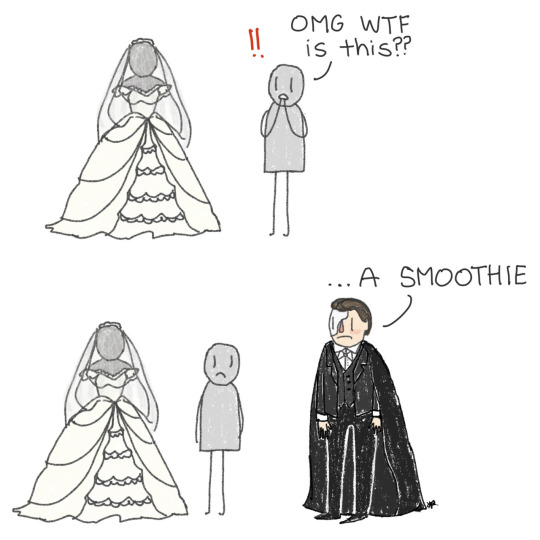



Blessed Be the Fruit/Handmaid's Tale AU
doodles from chap 1 *, 5, & 8 (+ more CURSED IMAGERY*)

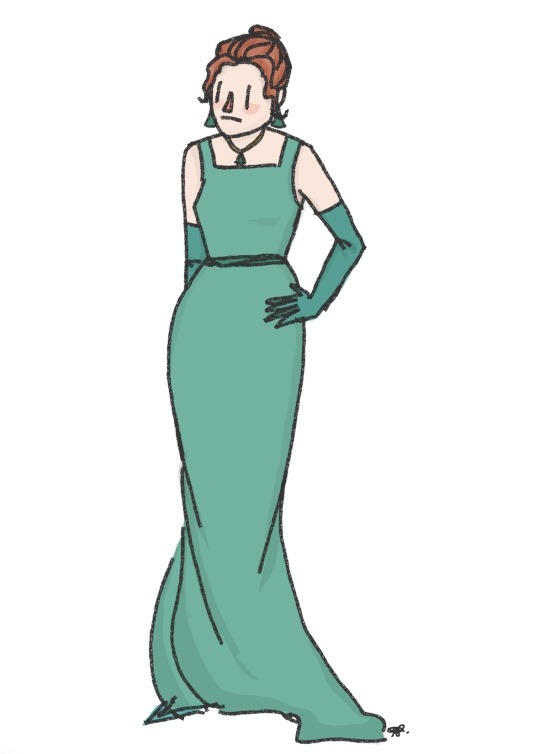
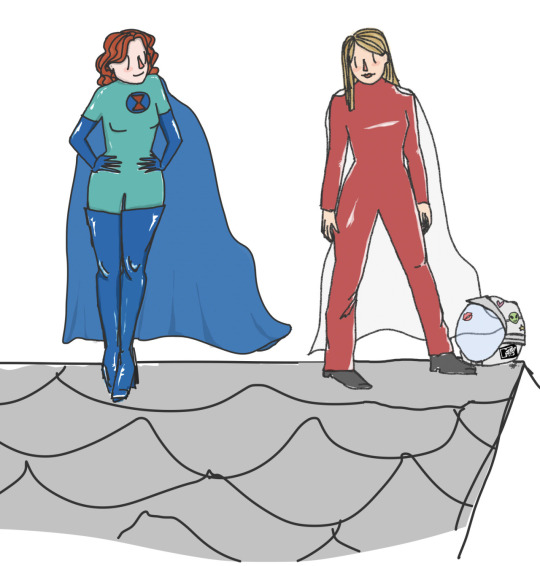

Check Out Any Time You Like/Hotel Cortez (AHS) AU
doodles from chap 2
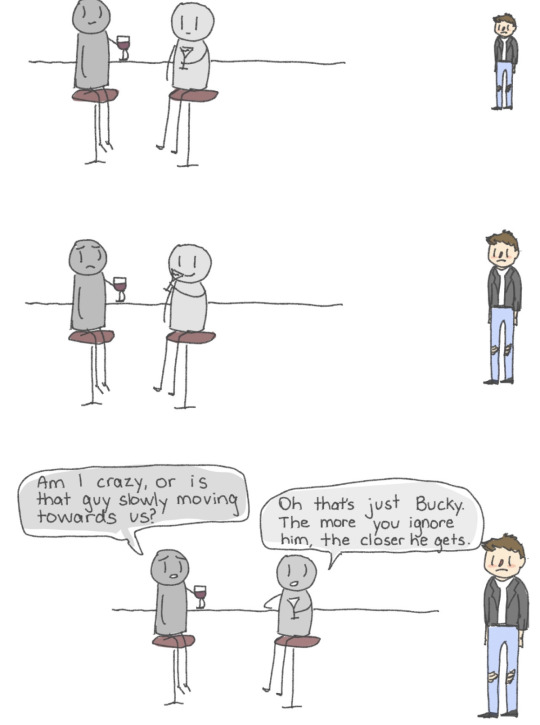
The Second Mrs. Rogers/Rebecca AU
doodles from chap 5, 7, & 9

(I had to take chap 7 doodles out bc dmg limit but it was Elle Woods inspired lol see them HERE)
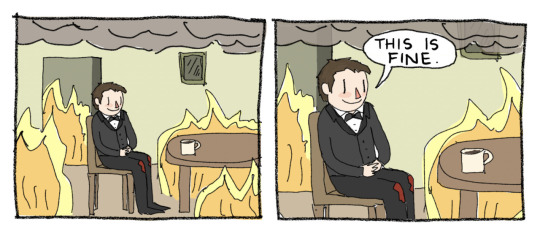
Thrill of the Kill
doodles from chap 1* & 2* (& 2 again* bc I'm bad at keeping track of things lol)
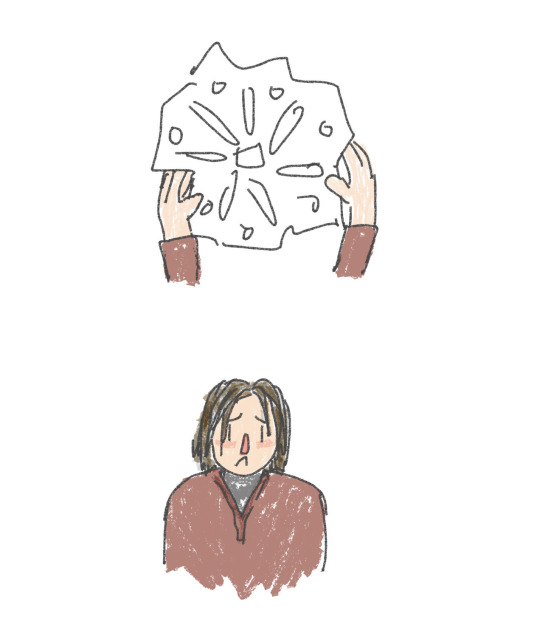

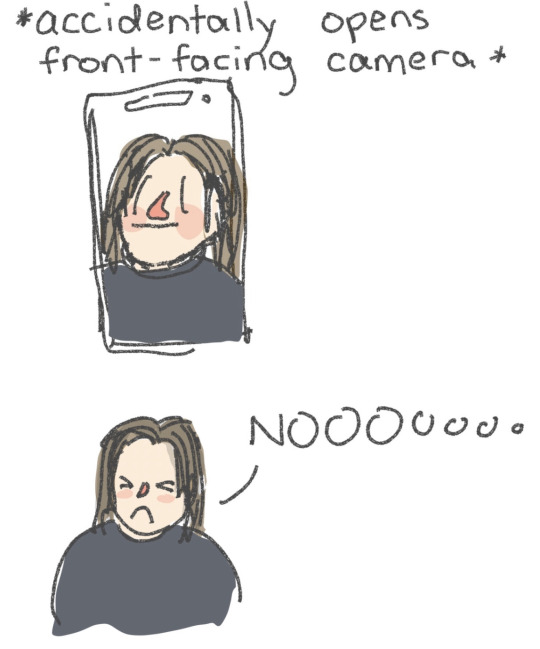
Be Thee Wolf of Sheep/Far Cry 5 AU
doodles from chap 1, 2*, 3*, 13* & BONUS LORE ;) *
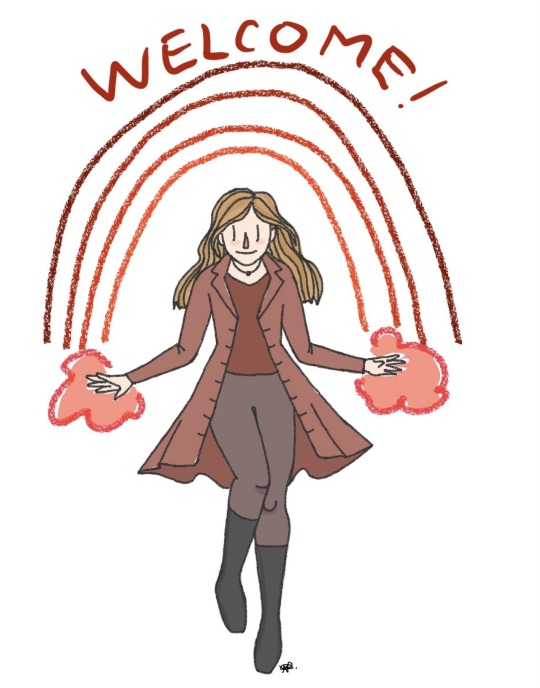
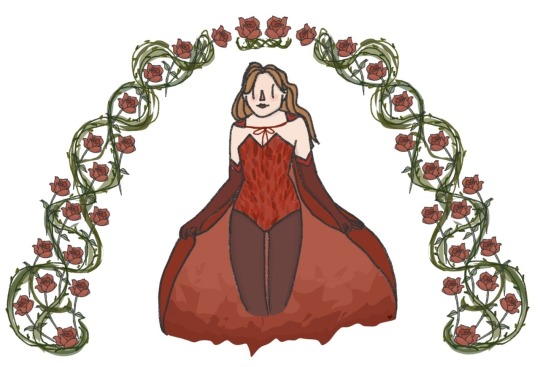



@buckymorelikefuckme
arOOOOOga* (click for +3 more doodles)
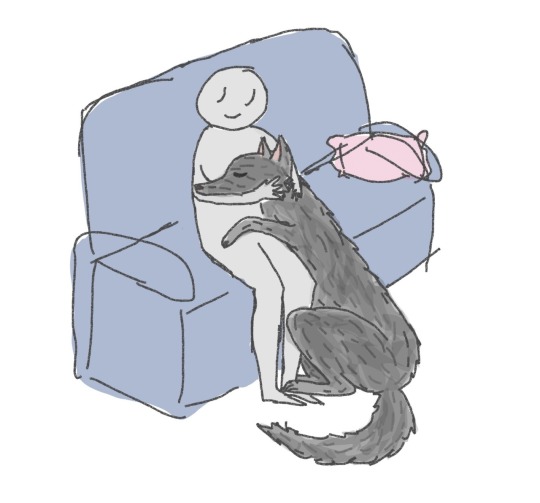
no shelf control* (click for full doodle comic)
@imyourbratzdoll
a bunny and elf special* (click for full doodle comic)

jennifer check x fem! pillow princess reader* (click for doodle!)
@darkficsyouneveraskedfor
God Mode* (click for full doodle comic)


Hue and Cry - part XXII
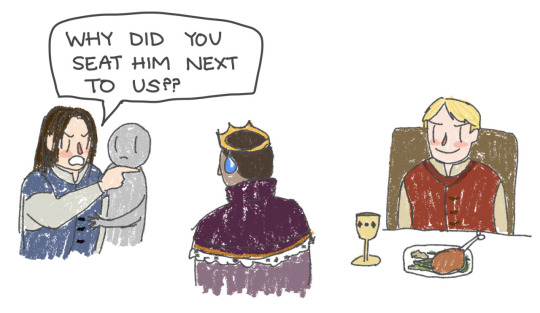
Who's the Boss - part 18* (click for +2 additional comic panels) & 22


@georgiapeach30513
Stained Like Georgia Clay - pt 16

@navybrat817
Two Sides of the Same Coin*(full doodle in link haha)
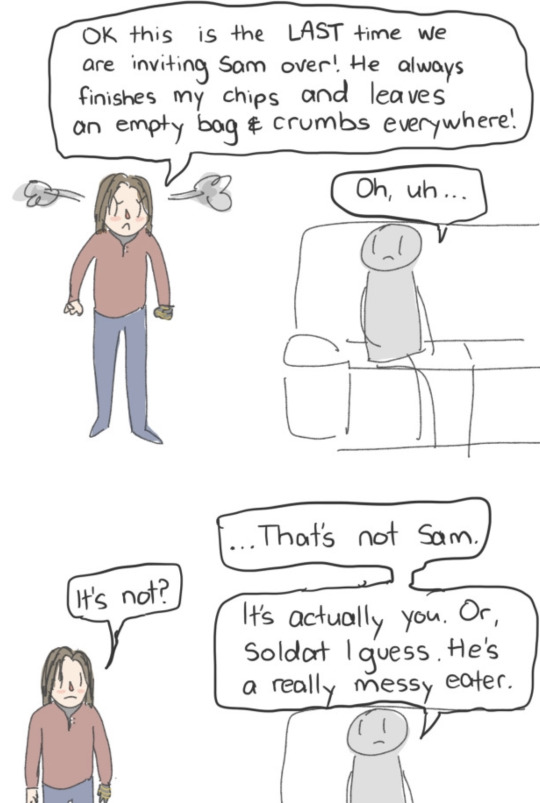
Prelude to A Kiss (click for doodle!)
@straywords
Y.O.U.
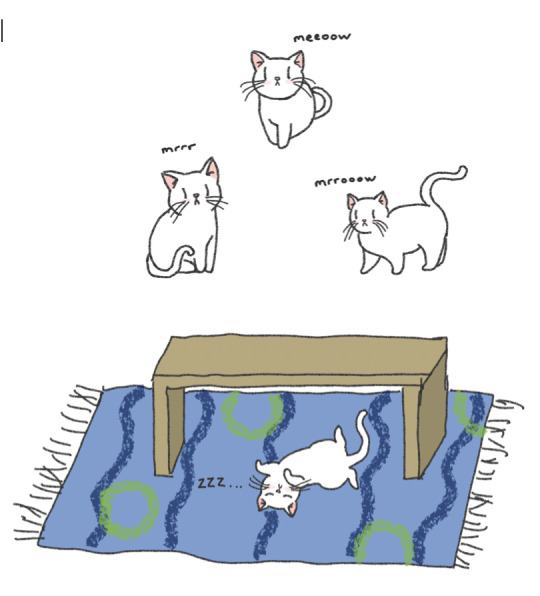
@thenhewaswrongaboutme
Your Hands Have Made Some Good Mistakes - pt 7

#Bucky barnes fanart#poto fanart#Steve Rogers fanart#Lloyd hansen fanart#fic recs#personally curated fic recs#fic art#fic rec masterlist#April fic recs#comics and doodles#IF IT’s UNDER A CUT WHY CANT WE PUT 999999 imgs tho
14 notes
·
View notes
Text
Don’t Worry Darling Spoilers
ShSo after lapping up all of the recent drama about Don’t Worry Darling, I went to see the actual movie.
Because everything about the promotion of the film and everything that has been surfacing about how it was made was so unprofessional, I expected a terrible movie. When I checked out the trailer I was actually intrigued - it was giving me a mix between Black Swan and Strange Angel. Still went to see it with the expectation of laughing at a train wreck... but I actually enjoyed it!
Here’s some of my thoughts (i’m trying to keep it spoiler light):
It’s promoted wrong: it’s a mindfuck movie. In fact, it could have been released under the name of Christopher Nolan and it might have gotten a lot of praise (if there hadn’t been so much bad press). Central to it the plot is gendered abuse. Why on earth the director - Olivia Wilde - is promoting it as a feminist movie and making ‘female pleasure’ such a strong talking point baffles me. See: gendered abuse. By the end of the story, I would qualify the sex that takes place as rape. If Olivia really believes what she says, that’s creepy as fuck.
There is some really disturbing imagery in the movie. Main themes are losing your mind, abuse, self-harm and gaslighting. Some of the scenes are graphic. Don’t go in unprepared just because you want to see a cute movie with Harry Styles (which it won’t be anyway).
Casting & Harry Styles: I think recasting Shia LaBeouf was a good choice, considering his real life and what’s been in the press about that. I think that would have left a viewer who knows that very uncomfortable at the end of the movie. Considering what the reviews have been saying about Harry’s acting, I expected him to be completely cringe all the time. He was actually okay in my opinion.
Chris Pine: This was the first time I’ve seen Chris Pine play a bad guy. It was an experience. I’ve followed this guy since Star Trek and I have a soft spot for him. Seeing him, successfully, play the sort of person that freaks me out was an experience.
Themes & Similar media: My original instinct that it would have somewhat similar vibes as Black Swan and Strange Angel were right. It also seems to take some elements from Hannibal, Upload, and The Truman Show. The way that the neighborhood is set up, in part stylistically, reminded me of the start of Fall Out III (the videogame) and say Tim Burton’s movies such as Edward Scissorhands. I liked these aspects. It might also have found some inspiration in the Handmaid’s Tale, but it can’t even hold a candle to that in a million years (which sometimes is also good, bc the Handmaid’s Tale is traumatizing AF in how hardcore it showcases certain premises).
Directorial criticisms: I tried to look really critically and there is some negative stuff to be said about Olivia Wilde as a director, but I don’t think it goes beyond flaws that can be pointed out in most movies. Several times the music felt a bit off for the scene. I didn’t like the camera angles often. Some scenes felt like there was a specific point to them, but the execution wasn’t quite it yet and sometimes thus came across a bit awkward. When I mentioned Hannibal, I specifically think they tried to recreate the flashing scary dream-like cutscenes and haunting music as part of the journey of a character losing their mind, but it was a poor copy (which is sad).
Plot & directorial criticisms: The final plot is, in my opinion, really really cool. And it had a plottwist I didn’t see coming. I was intrigued enough with how it unfolded to really want to follow the movie closely. But the above-point does show up here too in the sense that the ideas where there, but sometimes I needed to make some stuff up in my head to make it work. Some of the stuff that bugged me sort of seemed to be explained in the end, sort of. The weak spot for me was that Alice’s reactions seemed overstated for what we as the viewer saw as the cause of them. The things that were odd that she found out about, did not support the questions she consequently raised and the distress she had about it. The speed and intensity with which she lost her mind also didn‘t feel justified. Maybe the point was that she knew more than she thought the whole time and we as the viewers knew, and maybe we were supposed to notice this as odd as a clue. Maybe some of what happened can be chalked up to a sort of glitches in the matrix. It didn’t ruin the movie either way, and I don’t hate extending upon what we see onscreen in my head, but I do think the movie might have been stronger with a bit more exposition/build-up on some things on screen.
I am very mad that they got Dita von Teese to star in this, doing her signature performance, and we barely got to see it because it was intercut with so much of Alice’s trauma memories/nightmarescape scenes. Full offense!
Ending: I am sad the movie ended right at the moment where Alice fully grasped what was going on. I would have liked to have seen a bit more of her dealing with the aftermath. I think that would have made a stronger emotional journey for the viewer.
World-building: I must admit I am really fascinated with the premise/world-building of the movie, and there are so many aspects of it that I would have enjoyed knowing more about. I’m sort of sad it wasn’t told in a TV format so there would have been room. I’m very curious about the creation of the Victory Project and Frank’s character motivations. I am also very curious about Shelley’s position in all of it. I am curious about the struggles that would come with maintaining the situation around Alice (which also raises the question about how time works for the Victory Project). I also would have loved to know more about the stories of the other residents - it could have some very powerful tales about gendered violence (e.g. think of the implications of the character who was referred to as ‘always pregnant’). I am also interested in beyond the domestic aspect, how much of the world-building is set up in such a way as to fulfill specific power fantasies for the men. Does Jack get a big promotion and the opportunity to dance in front of everyone, because that is what he desires? Also, to how much beyond the domestic trad!wife fantasy is the Victory Project intended to cater? What would happen if a guy applied who doesn’t want to bring a wife, maybe someone who just thinks the aesthetic is really neat? What happens if a gay man applied who wants to bring a husband?
Overall, I liked the movie. The premise / plot was great, the execution okay. I do think that if it hadn’t been tanked so hard by a bad rep created by all the negative things that have surfaced about its production and the horrible promotion of it, it might have done well. I think most of the flaws it displays tie to lack of experience or talent from the director. But I also do think that there is a chance it wouldn’t have been judged as harshly if it had been directed by a man.
51 notes
·
View notes
Text
Spoilers
5x10 Safe
My thoughts...
I do love that they used Billie Eilish's Bury a Friend as ending music to episode it was perfect for that moment between June and Serena. And of course after the whole episode of not seeing her, Serena would pop up on the same train June's on. Not that I mind it too much. If we like it or not it seems those are going to be floating in and out of each lives more and more.
What I wasn't happy with the imagery of masses of people being put on trains late at night being only told they're going West. It reminded me too much of a certain group back in the early 1940 putting masses of certain groups of people on the trains not telling them where they were going, they ended up at concentration camp where they were tortured and murdered. I'm not sure if that was the visualization they were going for if they were trying to actually have a stink back to that or not. Because The Handmaid's Tale is a dark show so it could have been done purposely. If that was for reason that's fine and I'd like to know what the reason was used. But if not I'm really not happy about that imagery especially if it was done and they weren't consciously thinking about it. Although it could of just hit me that way.
Janine coming back to herself as it were in the 11th hour I thought was brilliant. It was like hearing June's name or news snapped her right back to herself. Madeline Brewer is so outstanding and freakin powerful as Janine. Love how she told the now Mrs. Lawrence off!! I am worried about her now though.
Nick is in heap big trouble. I'm not surprised by his actions watching him punch Lawrence was highly entertaining. Let's be honest his marriage to Rose was always going to an issue on any number of levels. But I'm more scared what they may do him now. Especially with who Rose's father is. I think that's going be the bigger issue then he punched another Commander.
I'm not sure how I feel about what Luke did. Didn't Mark give them fault identifications for both June and Luke? Or did I misunderstand something. So why didn't Luke use them? Or is he right leaving his wife and (not ready his) child again is the better option. But for who him or them? I'm just not sure if he's being selfless or selfish again. Only time will tell.
Ok not cute show having June be run over by an asshole in a truck!! Nearly lost my dinner, I know the is show always fucking with June; doesn't mean I like it! Especially when she ran over, that's too close!! Luke did do a very good thing by stopping that asshole and protecting his wife though.
I will say this season definitely went unexpected direction from where I thought it might go. For me it was a bit of slow start but now after watching the whole thing it's more like when your slowly climbing that hill on a roller coaster then you get to top... then it's crazy ride the rest of the way. Yea for me that explains season 5 of The Handmaid's Tale. Can't wait for season 6, even though it's the final season.
#the handmaids tale season 5#spoilers#05x10#safe#the handmaids tale spoilers#the handmaid's tale#june osborne#serena joy#nick blaine#luke bankole#commander lawrence#janine lindo
18 notes
·
View notes
Text
Love the water and blood imagery throughout episode 106 of The Handmaid’s Tale - the episode opens with water erasing blood from the wall and later we see it washing the blood from Junes mouth after trying to violently scrub away the memory of Fred’s mouth on hers.
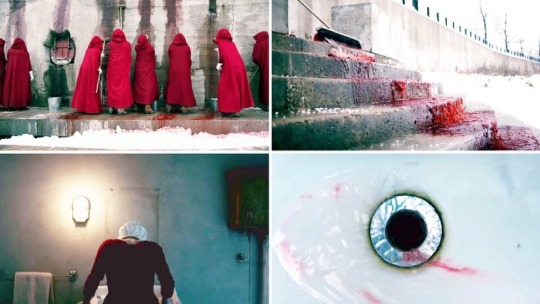
#above the garage#above the garage podcast#the handmaid's tale#june osborne#nick blaine#osblaine#nick x june#serena waterford#fred waterford#gilead#aunt lydia#janine lindo#luke bankole#moira strand#emily malek#commander lawrence#the handmaids tale season 5
10 notes
·
View notes
Text
Have you ever been enjoying a film or TV series, only to suddenly find yourself squinting at the dark screen? Recent releases including “Euphoria,” “The Batman” and “Handmaid’s Tale,” as well as classic films including “Alien,” “Taxi Driver” and “Seven” all utilize dark imagery, but what if the visuals are simply too dark to see everything in the frame?
While dark scenes are usually due to the filmmaker’s vision, there are several factors both at movie theaters and when viewing at home that will affect the viewer’s ability to see what’s going on onscreen.
Home viewing
For home viewers, one culprit could be the viewing environment, according to digital imaging technician Nicholas Kay. When he goes to visit his parents’ house, he’s aghast at the butchered image quality on their television screen, which Kay believes should be as neutral as possible. As someone who spends countless hours perfecting visuals on- and off-set, he feels personally offended by the settings on his parents’ TV, from motion smoothing to brightness, which Kay said shouldn’t be turned up or down.
“They watch this stuff, and I’m like, ‘Oh my God, you’re killing me, like please, let me help you,’” Kay said. “And then I help them, and they’re like, ‘Oh, what happened?’ I’m like, ‘What do you mean, what happened? This is how you’re supposed to see it!’”
The settings on a TV are just one factor when it comes to how a film is ultimately viewed. Other determinants might be the lighting in the room or the size and quality of the monitor.
Images in movie theaters, which should provide the ultimate viewing experience for cinephiles, can be just as dark as a badly adjusted home screen. Many projectors are not well maintained and even 4K resolution can fall flat.
But ultimately, the reason a movie or series seems super dark is that it’s how the filmmaker intended it to look.
A few years ago, a final battle in the “Game of Thrones” finale was criticized by many viewers for being so dark that it was impossible to see what was going on. Cinematographer Fabian Wagner defended his work at the time, telling Wired, “Everything we wanted people to see is there.” He also pointed out that the scene was shot at night and said the intention was to differentiate the battle aesthetically from other scenes throughout the series. He also stressed that watching the show anywhere other than a darkened room with a neutral, large monitor was a disservice to the viewer.
Mood-setter
Other than the viewing environment, though, Kay, a two-decade industry vet who has worked on movies including “Joker,” “Venom” and “Black Panther,” said there are practical and emotional reasons for dark images. Whether “dark” refers to the moodiness of a piece of media or its literal lack of light, the two often go hand-in-hand.
Matt Reeves’ “The Batman” takes place largely at night, “The Handmaid’s Tale” is set in a gloomy dystopia, and horror movies like the “Fear Street” trilogy rely on the cover of darkness to keep viewers on their toes. Those works and more have all faced criticism for being too shadowy (the West Wind Drive-In in Las Vegas told patrons that they couldn’t get a refund for “The Batman” if they found it too dark) but the alternative might be an unrealistic depiction of the plot.
“I think that a lot of cinematographers, when they do certain things like that, they’re trying to make it feel extremely truthful,” Kay said. “I don’t think the intention is to struggle to see, but there are times where I personally feel like I’m struggling, like, ‘Is it taking me out of it?’ My job really is to calibrate my eye to what the cinematographer wants it to look like.”
Of course, it’s not just newer titles that have viewers straining their eyes. Over the years, films from “Alien” (1979) to the aptly titled “Dark City” (1998), have been presented with extremely dark images. One difference, Kay says, is that those movies were shot on film, while most modern cinema is shot digitally. Even the digital remasters of those classic films might appear much flatter than the original, because 35mm film has two to three times more grains per square inch than 4K has in pixels. That means cinematographers have to get creative when it comes to crafting a unique and “organic” image.
“What they’re fighting is the sharpness and the crispness and the perfection of digital,” Kay said. “That’s what they would all say, and that’s why they want to shoot on film or that’s why they want to use a lot of smoke and filters — to basically take away the perfection.”
‘Euphoria’s’ Special Treatment
One of the most notable deviations from the digital landscape is Sam Levinson’s HBO teen drama “Euphoria.” The show’s second season was shot on 35mm Kodak Ektachrome, which forced Kodak to convert part of its factory to produce the discontinued film stock.
“Euphoria” has become well-known for its unique visuals, and cinematographer Marcell Rév said the stock’s film speed of 100 ISO (the metric for how much light the film picks up) forced them to light the set “like we were lighting a sitcom.” The result is an extremely textured final image that allows Rév to play with light in ways most filmmakers can’t, and he acknowledged that contrast is an important aspect of his vision.
“We were trying to do like velvety deep shadows, but I don’t think they are dark,” Rév said.” You always have very bright reference points in every image. I don’t think there are images where you’re wondering what’s on the image.”
Rév said he doesn’t believe that films are trending darker or lighter in general, but noted one inspiration in the world of film noir: David Fincher — specifically his 1995 film “Seven.”
“It’s a really dark [film],” Rév said. “That revolutionized the way they shot movies in the ‘90s, the way that [cinematographer] Darius Khondji used film stock and how he underexposed film stock and how he lit that movie. It was something so original and unique. It was in the ‘90s and it was way darker than anything I can see now in the cinema.”
In “The Batman,” Reeves and cinematographer Greig Fraser employed a technique similar to Khondji’s, where they printed the digital print of the movie onto film and used a bleach bypass to achieve a more high-contrast image. The technique marries aspects of film and digital, and creates a more textured look than most digitally shot superhero movies would allow.
As a technician who entered the industry as it was transitioning from film to digital, Kay’s job, he said, is often to help directors and cinematographers capture the essence of the films they grew up watching, trying to emulate the look and feel of film without any special treatment from Kodak.
Kay said that ever since digital has taken hold, studios have also gained more control when it comes to the final product. As a result, he said he believes many films are actually brighter than they need to be, with the exception being the works of well-known auteurs and cinematographers who have full control of the resolution and coloring of their movies. He referenced the work of his friend, cinematographer Bradford Young, who has shot films including “Solo: A Star Wars Story” (2018), “Arrival” (2015) and the 2019 mini-series “When They See Us,” which Kay also worked on. Those works all utilize dark imagery, but Kay said that’s entirely on purpose.
“He likes things darker, as an example of people who like to be more honest with the image, and certain scenarios and scenes are dark,” Kay said. “‘When They See Us,’ I know, was dark and smoky, but it was meant to be this organic, visceral experience where these kids are suffering.”
Lighting darker skin tones can also lead to problems for cinematographers, and the industry has only recently begun to acknowledge the inequity faced by Black actors and other people of color on screen. Many of the technologies used for lighting have been historically calibrated for white people, which is why the work of cinematographers like Young and Ava Berkofsky on “Insecure” has contributed so much to the craft.
In terms of his work on “Joker” (2019), photographed by Lawrence Sher, and “Venom” (2018), photographed by Matthew Libatique, Kay said the dark visuals were justified.
“‘Joker’ wasn’t even that dark to me,” Kay said. “It was more dark in theme. I don’t feel like you’re struggling to see it. It’s more like it takes place at night a lot of times or on subways or things like that. You know, the lights are going on and off … It’s all practically motivated.”
Beyond aesthetic or practical motivation, though, sometimes the reason for a scene’s dark lighting is much more mundane. If a movie utilizes special effects makeup or if a shot picks up lighting cables in the background, the darkness provides a great solution for hiding things that filmmakers don’t want the audience to notice. The modern techniques of CGI and VFX editing can fix the issue, but for lower budget projects, the old-school way is often much easier.
“‘Just paint it black’ is literally the answer to everything,” Kay said. “‘Alien’ is a great example of hiding things like prosthetics, all that kind of stuff. Those prosthetics look real, because they’re in a real environment and they’re lit realistically. To light them more, you start to reveal that they’re fake.”
Adjust Your TV
But, regardless of why an image seems dim, Kay has a few tips for making sure you have the best shot at seeing a film the way it was intended. He suggested Googling the make and model of your TV set to learn how to neutralize the settings, adding, “If a window outside is pointing at your screen, you’re fighting an uphill battle.”
When it comes to your local movie theater, keep an eye out for smudged screens or washed-out picture quality, and alert the theater manager. Make a point of patronizing cinemas that prioritize the viewer experience, such as AMC’s Dolby Cinemas or Alamo Drafthouse.
When it comes to lack of control over how someone will watch one of the projects on which he spends months perfecting the imagery, Kay takes the challenges of his work in stride.
“Most people are gonna be watching this on an airplane or an iPhone anyway,” Kay said, “but that doesn’t stop you from trying.”
6 notes
·
View notes
Text
S5 E2: The Evil Queen
These are my observations and feelings after watching Episode 2 of Season 5 of The Handmaid's Tale.
Please watch the episode before you read.
(Contains details from and discussion of the episode).
I am SO EXCITED they're going with this classic fairytale archetype for Serena.
It's so deeply evocative. Hits hard. Will be very satisfying when they finally take her down.
Think of what Serena showed June without speaking a fucking word.
Handmaids kneel to me.
Your lover is my Knight. My soldier. He serves at my right hand.
Your daughter honors me. I will be her mother now.
Serena is making good on her threat from S1. As long as my family is safe, yours is safe.
Serena has June's family ensnared. Even if they don't see it from their vantage, June does.
I LOVE THIS imagery bc June fucking Osborne isn't gonna let that shit fly, ya'll. She's gonna march the fuck back in there and GET HER MAN!
10 notes
·
View notes
Note
Hey, I like your blog, but jsyk, The Handmaid’s Tale makes a lot of people really uncomfortable. Margaret Atwood has supported someone with allegations of sexual assault, and The Handmaid’s Tale is kinda racist, and she’s really transphobic. These marginalized identities are already going through a lot right now, so if you want to make us feel welcome, I strongly recommend avoiding Handmaid’s Tale imagery in the future. Thanks for listening.
Thank you for letting me know.
14 notes
·
View notes
Text
not me seriously considering giving The Handmaid’s Tale another try JUST for this imagery.
#the black veil and white roses paired with the statues wings and the whole ethereal image for serena#the strict expression and snow white outfit and short poised curls of june#(ironically she's the one that fits my mental image of a curly haired blonde lucifer here lmao)#that eye contact tm. the hate. the smirk. i love all of it so much#ugh#i think i should keep it on storage until the show ends and then decide if it's worth it#talking to the void#my thoughts#the handmaid's tale#tht thoughts
6 notes
·
View notes
Text
glad I can still come back to tungle dot com to avoid the “mandatory vasectomy jokes are promoting eugenics” and “handmaid’s tale imagery is racist” takes on Instagram!
8 notes
·
View notes
Text
I really hate all the Handmaids Tale imagery associated with the battle for reproductive rights. Maybe because I don’t like the Handmaids Tale as a form of media, maybe because I don’t think using that imagery is particularly convincing to right-wingers when it’s clearly thought of as stunning metaphor by ineffectual white liberals.
It’s very much the 2020s equivalent of when people were saying there were Death Eaters in the White House, or when people compared x political episode of the 2010s to the Hunger Games. I… just. This is a massive issue? And it feels trivialized by this?
8 notes
·
View notes